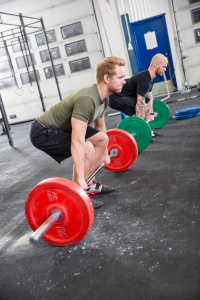 The focus of maximizing muscle fiber recruitment is often associated with using more weight, or doing more reps, but the force factor is often overlooked. In other words, if you are not lifting a very heavy weight, or you are not pushing a set to failure, it is often assumed that you are lacking the necessary mechanisms to trigger muscle fiber recruitment. This does not have to be the case if you lift weights forcefully.
The focus of maximizing muscle fiber recruitment is often associated with using more weight, or doing more reps, but the force factor is often overlooked. In other words, if you are not lifting a very heavy weight, or you are not pushing a set to failure, it is often assumed that you are lacking the necessary mechanisms to trigger muscle fiber recruitment. This does not have to be the case if you lift weights forcefully.
Sprinters and jumper must recruit a high degree of muscle fibers to generate the necessary speed and force to sprint and jump, but they are not using heavy weights or sprinting or jumping to failure. Technically a sprinter or jumper may be moving so rapidly that the motion does not permit sufficient time for an absolute maximum muscle contraction to occur. However, when you apply force production and speed to lifting weights that are even moderately heavy, the problem is resolved as the resistance slows the motion down enough to permit maximum muscle fiber recruitment for maximum contractions.
More Force Equals More Muscle Fiber Recruitment
The point is that when you lift weights, the more acceleration and lifting force that is applied when lifting a given weight, the more muscle fibers will be activated during the exercise. This applies when lifting light weights, medium heavy weights, and heavy weights. The faster you lift the specific weight you are using, the more muscle fibers are recruited. If you take a moment to watch the following videos, you will see that Jay Cutler, Dan Kovacs and the lifter who is doing deadlifts all lift powerfully and forcefully as it is an effective means for gaining strength.
Jay Cutler Benching 405
Dan Kovacs Benching
Deadlifts for Speed and Power
Your Body Wants a Weight To Become Easier to Lift
The only way to gain the ability to lift the same weight faster and faster is to gain strength. When you gain strength in this manner, the same weight gets easier and easier to lift. The whole goal of your body when it gains strength is to make a given weight easier to lift. When you gain strength by lifting the same weight faster, your body succeeds at accomplishing its goal. However, if you immediately add weight or reps each time you gain strength, a difficult lift will never get easier. The problem with this is that workouts will perpetually remain hard and your body will eventually lose its desire to gain strength because it produces no benefit for your body when workouts never get any easier.
Eventually you will need to add weight or reps, but I don’t recommend it as the first means of progression; it should be the second means of progression. Increasing force, acceleration, and rep speed should be the first means of progression, and adding weight or reps should come afterwards.
Lift Faster First, Then Add Weight or Reps
It seems counter intuitive to most lifters to allow workouts to become easier by improving lifting force and rep speed with the same weight, but after over thirty years of weight training experience, I have found it to be a far better method for consistent progress than to focus on adding reps and weight as the first means of progress. This especially holds true if you stay within the boundaries of your marker rep, limit rep, and limit set. My suggestion then is to focus on improving force, acceleration, and rep speed first, and then to add weight or reps after this has been accomplished. Best of training to you.
